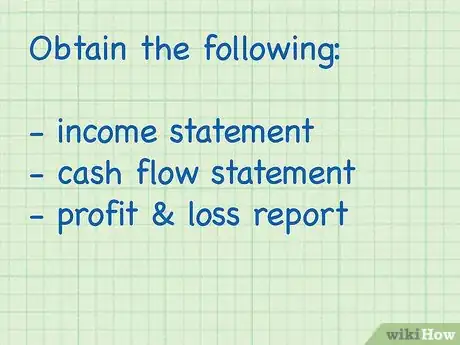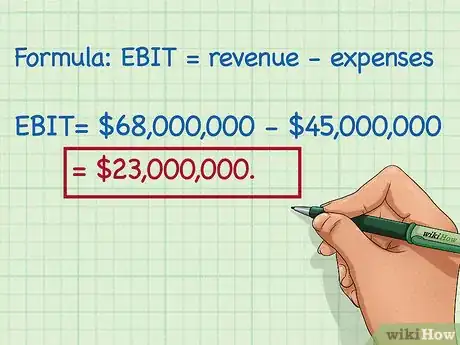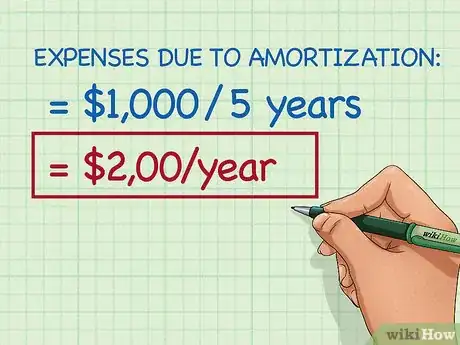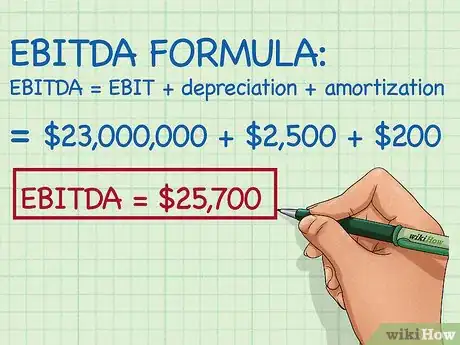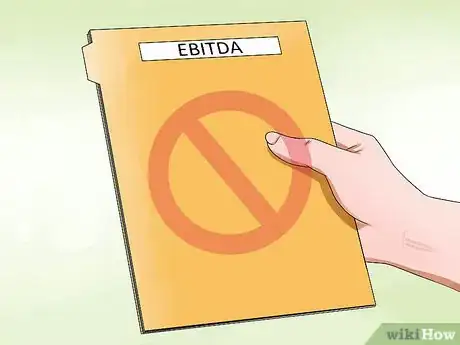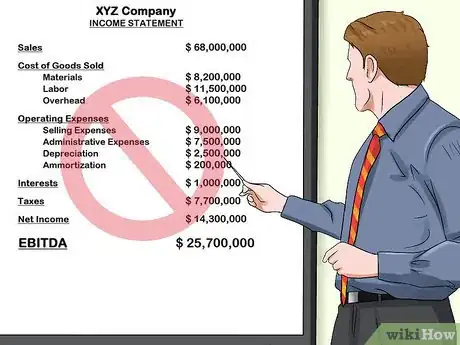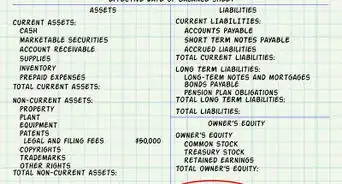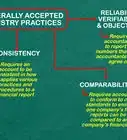This article was co-authored by Darron Kendrick, CPA, MA. Darron Kendrick is an Adjunct Professor of Accounting and Law at the University of North Georgia. He received his Masters degree in tax law from the Thomas Jefferson School of Law in 2012, and his CPA from the Alabama State Board of Public Accountancy in 1984.
wikiHow marks an article as reader-approved once it receives enough positive feedback. This article received 15 testimonials and 86% of readers who voted found it helpful, earning it our reader-approved status.
This article has been viewed 1,145,735 times.
Earnings before interest, taxes, depreciation and amortization, or "EBITDA," is one measure of a company's operating efficiency. EBITDA is a way to measure profits without having to consider other factors such as financing costs (interest), accounting practices (depreciation and amortization) and tax tables. Calculating EBITDA is usually a fairly simple process and, in most cases, requires only the information on a company's income statement and/or cash flow statement. Note that caution should be taken when using EBITDA as a measure of a company's overall financial health - its use as such is somewhat controversial.[1]
Steps
EBITDA Calculator
Calculating Your Company's EBITDA
-
1Obtain your company's income statement, cash flow statement, and/or profit and loss report. EBITDA is fairly to simple to calculate with just a few of your company's important operating metrics. To calculate EBITDA, you'll want verifiable information regarding your company's earnings, tax and interest expenses, and depreciation and amortization expenses. Usually, earnings, tax, and interest figures are included on a company's income statement, while depreciation and amortization figures are found in the notes to a company's profit and loss report or on its cash flow statement.[2]
-
2Find the operating profit (EBIT) on the income statement. This is the company's revenue minus its expenses (without taking taxes and interest into account).[3] The expenses include amortization and depreciation.
- To calculate EBIT manually, subtract your expenses (besides interest and taxes) from your sales revenue. For example, let's say we own a construction company whose revenue for the past year was $68,000,000. However, our operating expenses were $45,000,000. In this case, our company's operating profit (EBIT) = revenue - expenses = $68,000,000 - $45,000,000 = $23,000,000.
- Expenses include: depreciation, amortization, salaries, rent & utilities, cost of goods sold, selling, general and administrative expenses.
Advertisement -
3Sum any expenses due to depreciation.
- Assets that a company owns can decrease in value over time through natural wear and tear and through fluctuating market conditions. Expenses incurred in this way are known as expenses due to depreciation.
- Usually, depreciation expenses are listed on a company's profit and loss report or on its cash flow statement. Find and add up any itemized depreciation expenses to obtain a single total for your company's depreciation expenses. Record this value - it will be needed to calculate EBITDA.
- For example, let's say our construction company purchased several buildings a few years ago and that their combined value was $8,750,000. These buildings have an estimated useful life of 35 years. In this case, assuming linear or straight-line depreciation, the cranes will collectively depreciate $8,750,000/35 = $250,000 per year.
-
4Sum any expenses due to amortization. Amortization is related to depreciation but is not technically the same. Amortization refers to expenses incurred from the acquisition of an intangible asset over the length of the asset's life, whereas depreciation refers to tangible assets. Usually, amortization expenses are listed along with depreciation expenses on a profit and loss report or on a cash flow statement. Add up any itemized amortization expenses to obtain a single total and record this value.
- For example, let's say that a few years ago, our company spent $100,000 to obtain certain industry trademarks. Let's say that this amount of money bought us the rights for five years.
- In this case, the expense due to amortization would be $100,000/5 = $20,000 per year.
-
5Calculate EBITDA via the formula EBIT + depreciation + amortization = EBITDA. Add your total expenses due to depreciation and amortization back to your company's EBIT. EBITDA is a measure of earnings before interest, taxes, depreciation and amortization. Since depreciation and amortization were already deducted to find EBIT, you need to add them back in to obtain EBITDA.
- In our construction company example, let's assume that the depreciation and amortization expenses calculated above are the only ones our company incurred (in real life, obviously, we may have to add multiple depreciation and/or amortization expenses to obtain a total value).
- In this case, we could calculate via the formula EBIT + depreciation + amortization = EBITDA. $23,000,000 + $250,000 + $20,000 =$23,270,000. Our company's EBITDA is $23,270,000.
Using EBITDA Data Responsibly
-
1Don't use EBITDA as the sole measure of your company's financial health. EBITDA has some usefulness in financial analysis. For instance, it's an easy way to define how much money your company has to pay off outstanding debts in the short term - if a company that has $2,000,000 in interest payments but $3,000,000 in EBITDA, it can be argued that the company has plenty of money to pay off its debt. However, because EBITDA doesn't account for important expenses and because it's easily manipulated, it's unwise to use it as the only measure of your company's vitality.
- EBITDA isn't necessarily a good indication of whether your company is losing money or making money. It's possible, for instance, for a company to have a positive EBITDA but a negative operating cash flow. Because of this, EBITDA can make a company look much healthier than it actually is.
-
2Don't purposefully manipulate your company's EBITDA. EBITDA can be manipulated by unscrupulous accounting practices. For example, because depreciation and amortization are determined relatively subjectively (via projections, estimates, and experience), it's possible to change a company's EBITDA by altering depreciation and amortization schedules. Though depreciation and amortization are non-cash expenses (cash has already been exchanged for the depreciating/amortizing assets), but they exist for a reason. Eventually, equipment fails and intangible assets expire. When this happens, very real cash expenses result.
- As a real-world example of EBITDA manipulation, some airline companies have altered the depreciation schedules on their aircraft to make their EBITDA appear larger.[4]
-
3Don't use EBITDA data to misrepresent your company. One of the biggest reasons that EBITDA has come under fire as a useful metric is that it can be used to misinform investors and lenders. For instance, in certain industries loan limits are sometimes set as a percentage of EBITDA[5] , so, by manipulating their company's EBITDA, business owners can mislead lenders into giving larger loans than they normally would. Fraudulent practices like these designed to swindle a company's stakeholders are unethical and can even be illegal.
References
- ↑ http://blogs.hbr.org/2009/11/how-ebidta-can-mislead/
- ↑ http://www.investopedia.com/articles/06/ebitda.asp
- ↑ http://www.investopedia.com/terms/o/operating_profit.asp
- ↑ http://blogs.hbr.org/2009/11/how-ebidta-can-mislead/
- ↑ http://blogs.hbr.org/2009/11/how-ebidta-can-mislead/
- http://moneyterms.co.uk/ebitda/
- http://www.investopedia.com/articles/analyst/020602.asp
Expert Q&A
Did you know you can get expert answers for this article?
Unlock expert answers by supporting wikiHow
-
QuestionIf I am sole proprietor of a small business, doesn't my salary make EBITDA near zero? When I add my salary to the employee EBITDA section, it goes up.
 Darron Kendrick, CPA, MADarron Kendrick is an Adjunct Professor of Accounting and Law at the University of North Georgia. He received his Masters degree in tax law from the Thomas Jefferson School of Law in 2012, and his CPA from the Alabama State Board of Public Accountancy in 1984.
Darron Kendrick, CPA, MADarron Kendrick is an Adjunct Professor of Accounting and Law at the University of North Georgia. He received his Masters degree in tax law from the Thomas Jefferson School of Law in 2012, and his CPA from the Alabama State Board of Public Accountancy in 1984.
Financial Advisor
-
QuestionHow does owner distribution affect EBITDA? For example, if my net income is 20 M, and then 4 M is allocated to distributions to owners, is the company still a 20 M in EBITDA company?
 Darron Kendrick, CPA, MADarron Kendrick is an Adjunct Professor of Accounting and Law at the University of North Georgia. He received his Masters degree in tax law from the Thomas Jefferson School of Law in 2012, and his CPA from the Alabama State Board of Public Accountancy in 1984.
Darron Kendrick, CPA, MADarron Kendrick is an Adjunct Professor of Accounting and Law at the University of North Georgia. He received his Masters degree in tax law from the Thomas Jefferson School of Law in 2012, and his CPA from the Alabama State Board of Public Accountancy in 1984.
Financial Advisor
Warnings
- It is worth noting also that EBITDA, alone, should not be used to evaluate your company's financial health but can be used in combination with other indicators, such as cash flow.⧼thumbs_response⧽
- It should be noted that EBITDA should not be confused with "cash flow." Those who value EBITDA consider it to be a way to calculate how much cash is available to pay debt over the long term. In addition, profits must be legitimate; EBITDA numbers can be manipulated to make the company's finances look better. Caution should be taken to ensure that there are "checks and balances" and that you are using sound accounting principles when using this method of evaluation.⧼thumbs_response⧽
- There is some controversy about the value of EBITDA. Some claim that it is not a true picture of your company's financial health because it avoids those expenses that were removed and they are actual expenses. Some believe that those expenses should be included in the overall financial picture of your company.⧼thumbs_response⧽
Things You'll Need
- Financial statements such as profit and loss report or cash flow statement
- Paper, pen or pencil
- Calculator
About This Article
To calculate “EBITDA”, or your company’s earnings before income, taxes, depreciation, and amortization, start by gathering the income statement, cash flow statement, and profit and loss report for your business. On the income statement, find your company’s operating profit, or “EBIT,” or calculate it by subtracting the total expenses for the year from the total sales revenue. Then, add the depreciation and amortization expenses from the profit and loss report or cash flow statement to the operating profit. The total is the EBITDA for the company. To learn more about how to use the EBITDA data for your company, keep reading the article!

